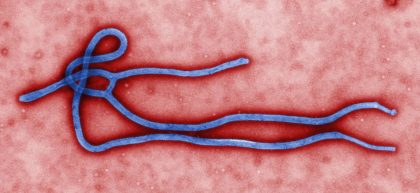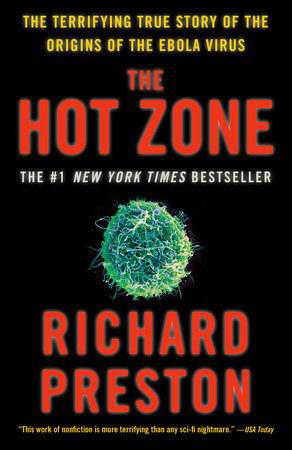
Richard Preston’s The Hot Zone was not my first introduction to emerging infectious diseases. The spreading HIV pandemic of the 1980s and 1990s prompted my initial interest and desire to make a positive contribution. Still, Preston’s controversial best seller likely introduced me to the Ebola virus and to concepts like biosafety level 4 laboratories. The same was true for many others, especially those outside of biological and medical communities. That Preston’s book raised awareness, increased enthusiasm for science & public health, and generated greater political will to prepare for outbreaks & provide aid where they occur were generally seen as positives among those who deal most directly with Ebola and related pathogens. At the same time, its exaggeration of the clinical effects and heavy dramatization led to some frustration within the same communities. The new TV mini-series adaptation seems likely to garner a comparable response.
The events are 30 years in the past now, but here’s a recap in case they are not familiar. Both versions The Hot Zone deal primarily with a 1989 outbreak of a previously unknown strain of Ebola among macaques imported from Philippines to Reston, VA for research. We first encountered Ebola when it infected humans in what was then Zaire in 1976. The fatality rate of the virus could reach 90%, particularly without supportive care to deal with dehydration and other medical complications. So when something that looked like Ebola turned up in a Northern Virginia suburb of Washington, DC, there was understandable concern. Fortunately, it turned out that this version was a related virus that made monkeys sick but not humans.
I most appreciated the time the TV show spends in the lab. Culturing viruses, using antibody cross-reactivity to identify them, and dealing with issues like bacterial contamination are familiar aspects of virological lab work. (Antibody cross-reactivity refers to using antibodies known to bind to a specific virus and checking whether they bind to an unknown virus.) Veterans with actual biosafety level 4 experience may find details to dispute, but the broad strokes rang true to me and gave some real texture to what could have easily been generic (or omitted) science sequences. Similarly, quarantine protocols and the precautions taken to protect the scientists & decontaminate any possible source of exposure are presented in some detail. The show has real appreciation for the training and expertise of those involved.

Those are largely ahistorical details however, not unique to this specific story. Less clear is how closely the narrative conforms to the details of history. Some license is expected and unavoidable. At the same time, some of the thematic concerns rest on the particulars. For example, characters discuss the question of whether to alert the public at various points over multiple episodes. Central to the conversation is a sick employee from the monkey facility; if he is infected, who should know and how should everyone around him be protected? In reality, exposure did not lead to symptoms in humans. And the argument for discretion (or secrecy and cover-up if you’re feeling less charitable) hinges on the possibility of a greater death toll from panic and riots. This line of thinking is informed by the experience of two characters who investigated the earlier outbreaks in central Africa, where villagers and soldiers responded to the disease with violence. But those two characters are fictional amalgamations, which makes me wonder just how fictional their flashbacks are as well.
In the years this story was being developed for the screen (basically on and off since the book was released), we have had actual human Ebola cases in the United States, with attendant media coverage. As part of my job, I played a small role in helping the Ohio Department of Health understand how hospitals and patients were responding when a healthcare worker who had traveled in Ohio was subsequently diagnosed. There was clear evidence people were concerned about becoming infected, yet these concerns were expressed peaceably. Granted, concerns and frustrations were expressed more stridently in West Africa. At the same time, the magnitude of what those people faced was far greater as well; I do agree with the show that humans everywhere are capable of the same kinds of reactions under similar circumstances. The conversation within the story may have made sense at the time, but any contemporary conversation should take into account the additional information we’ve acquired from subsequent experience.
I also wanted to comment on the final speech of the film. It depicts Ebola and other pathogens as akin to predators lurking in the shadows and implies they are our punishment for what we have done to the Earth. It is true that Ebola is a zoonotic infection, meaning it primarily infects animals but can infect humans or has mutated to infect humans. And urbanization and climate change are impacting the habitats of animals and creating more opportunities for people to have contact with novel diseases. However, viruses are not learning how to kill us more effectively. Viruses do not need to kill their hosts the way predators need to kill their prey; a virus that causes persistent infections without symptoms can spread more than a highly lethal one. Arguably new zoonoses like Ebola are more deadly because they haven’t learned how to co-exist with human hosts more productively, rather than because they have finally figured out how to kill us. So while I appreciate the desire to communicate how serious infectious disease outbreaks can be, I’m concerned using these terms and metaphors cultivates unhelpful intuitions.
I tuned because infectious diseases and public health overlap with my job. I can recognize some of the accurate depictions and some of the liberties taken because of that connection. For folks not familiar with those disciplines, how do you navigate programs like this to keep the facts and the fiction straight? Are there any popular books about your field that inspire similar mixed responses?
Andy has worn many hats in his life. He knows this is a dreadfully clichéd notion, but since it is also literally true he uses it anyway. Among his current metaphorical hats: husband of one wife, father of two teenagers, reader of science fiction and science fact, enthusiast of contemporary symphonic music, and chief science officer. Previous metaphorical hats include: comp bio postdoc, molecular biology grad student, InterVarsity chapter president (that one came with a literal hat), music store clerk, house painter, and mosquito trapper. Among his more unique literal hats: British bobby, captain’s hats (of varying levels of authenticity) of several specific vessels, a deerstalker from 221B Baker St, and a railroad engineer’s cap. His monthly Science in Review is drawn from his weekly Science Corner posts — Wednesdays, 8am (Eastern) on the Emerging Scholars Network Blog. His book Faith across the Multiverse is available from Hendrickson.

Really very happy to say,your post is very interesting to read. I never stop myself to say something about it. You’re doing a great job. Keep it up.